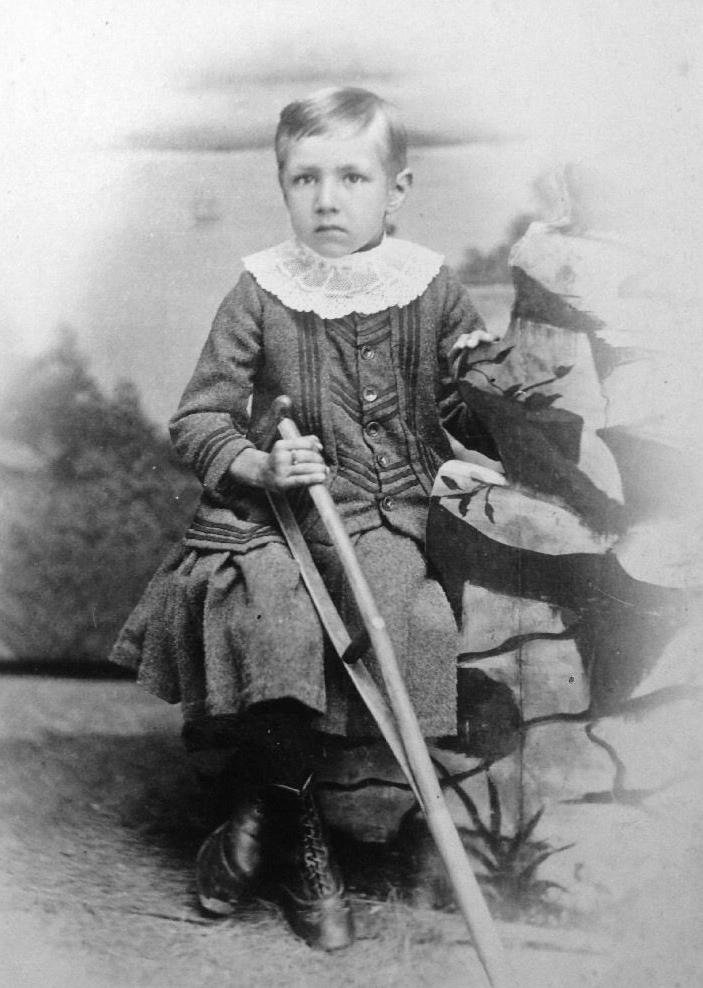
American Kilt Suit Age Trends: 6 Year Olds

Figure 1.--This cabinet card portrait shows an unidentifid boy wearing a skirted garment. We think it is a kilt suit, although lace collsrs were more common for dresses. It could be jscketed dress, a little hard to tell. The boy looks to be about 6 years old. He is holding a crutch, but we are not sure what the medical problem us. The studio was "L.J. Deguire, Appleton, Wisconsin. The portrait is undated, but we would guess was taken during the 1890s.
|
|
While kilt suits were primarily made for pre-school boys, we do see some 6-year olds wearing them. Not large numbers of 6-year plds, but we do see some. This was a relatively small number of the boys we have found wearing kilt suits. The prevalence in the photographic record suggests that it was not very common for older boys to wear them. As our American archive is fairly extensive, we believe that this is a realtively good reflection of the actual prevalence. Another indicator of the reltive prevalence of kilt suits is that we do not see them in school portraits and by the 1870s when kilt suits became increasingly popular, public school attendance was also becoming increasingly standardized. And we do not see boys wearing kilt suits to school. Our archive of 19th century school images is limited, but we do not see boys wearing kilt suits to school. You can see that in the individual 19th century school pages. Boys may have turned 6 after the September school cut off date. And that it means either kilt suits were worn by well-to-do boys who were tutored at home or boys wore kilt suits for special occasions after they were breeched. This we are not entirey sure about. But we do see 6 year old wearing them, although not at school. This cabinet card portrait shows an unidentifid boy wearing a skirted garment. We think it is a kilt suit, although lace collars were more common for dresses. It could be jacketed dress, a little hard to tell. The boy looks to be about 6 years old. He is holding a crutch, but we are not sure what the medical problem us. Unfortunately, there was no information on the card. The studio was L.J. Deguire, Appleton, Wisconsin. The portrait is undated, but we would guess that it was taken during the 1890s. A reader writes, "The way his head is looking not quite at the camera I would guess the medical problem has something to do with his neck or spine. Also we would have guessed the boy here was a little older, perhaps 7 or 8 years old. We also suspect that handicapped children kept at home for special care might be babied by mother, at least more than more robust children." Yes it does seem likely that many such mothers would be inclined to dress such dependent children more like younger children. Another reader writes
Another reader writes, "The boy has one leg shorter than the other. He wears a shoe with a built on higherb sole sole to compensate. The crutch is to help keep his balance. This picture could be used in a feature about childhood medical problems." Looking at tgecimage there does seem to be something added to his right shoe (at the left because he as croosed his legs). It is not real clear, however just how the shoe was modified.
HBC

Navigate the Boys' Historical Clothing Web Site:
[Return to the Main U.S. kilt suit age page]
[Introduction]
[Activities]
[Biographies]
[Chronology]
[Clothing styles]
[Countries]
[Bibliographies]
[Contributions]
[FAQs]
[Glossaries]
[Images]
[Links]
[Registration]
[Boys' Clothing Home]
Navigate the Boys' Historical Clothing kilt pages:
[Return to the Main American kilt suit page]
[Return to the Main kilt page]
[Lace collar]
[Floppy bows]
[Cut-away jackets]
[Kilt suits]
[Stiped long stockings]
[Shoes]
[Scottish kilts]
[Scottish boys clothing]
[Scottish school uniform]
[Highland dance]
[Irish kilts]
[Irish boys clothing]
[Irish step dancing]
[Greek kilts]
Created: 10:13 PM 1/2/2015
Last updated: 7:23 PM 1/6/2015



